John Page (planter)
Colonel John Page (baptized 26 December 1627 – 23 January 1692)[1]: 39, 41 was a planter, slave trader, merchant and politician in colonial Virginia. Born in Sudbury, Middlesex, Page eventually migrated to the colony of Virginia, where he lived in Middle Plantation and served as a member of the House of Burgesses from 1665 to 1677 and a member of the Virginia Governor's Council from 1677 to 1692. A wealthy landowner, Page donated land and funds towards construction of the Bruton Parish Church.[2] Page was also involved in the establishment of the College of William & Mary in 1693, as well as being a chief proponent of Middle Plantation being designated the colony's capital in 1698.
John Page | |
|---|---|
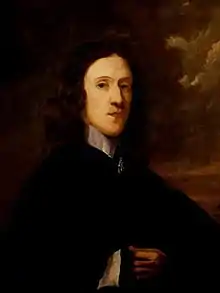 Portrait by Peter Lely (c.1670) | |
| Born | John Page December 26, 1627 (baptized) |
| Died | January 23, 1692 (aged 64) |
| Occupation | Merchant, politician, businessman, planter |
| Years active | 1645–1692 |
| Member of the House of Burgesses | |
| In office 1665–1677 | |
| Governor | Governor Sir William Berkeley |
| Member of the Virginia Governor's Council | |
| In office 1677 – January 23, 1692 | |
| Governor | Governor Herbert Jeffries Governor Thomas Culpeper Acting Governor Nicholas Spencer Governor Francis Howard |
His efforts eventually resulted in the renaming of Middle Plantation as Williamsburg in 1699, perhaps most well known as the birthplace of democratic governmental principals among Patriot revolutionaries before and during the American Revolution. In the 21st century, Page's Middle Plantation residence serves the modern home of the restored colonial-era tourism destination known as Colonial Williamsburg, a popular travel destination in Virginia.
Biography

According to the Genealogy of the Page Family in Virginia, published in 1883:
John Page, son of Thomas Page (b. 1597), of Sudbury, County Middlesex, England, seventh son of Richard Page, second son of John Page (b. 1528), first of Henry Page (b. 1500), of Wembley, County Middlesex, England, all of the Parish of Harrow, was born at Sudbury in A.D. 1627. He immigrated to America about 1650 at about 23 years of age, and became the progenitor of the Page-family in Virginia.[1]: 14–15
John Page's niece Mary Whaley (daughter of his brother Matthew and wife of James Whaley of Bruton Parish, York County, Virginia) is buried in the churchyard.[3][4]
John Page became a merchant, and emigrated to the Virginia colony; his sister Elizabeth (wife of Edward Digges) and brother Matthew also emigrated to Virginia. In about 1656, John Page married Alice Lukin,[5] (1625–1698) perhaps the daughter of Edward Lukin, a Virginia Company shareholder.[6] The Pages originally lived in the New Towne section at Jamestown.
The Pages settled in York County in 1655. In 1662, the Pages had a large brick cross-plan house built in nearby Middle Plantation. A wealthy landowner, Page owned 330 acres (1.3 km2) in Middle Plantation, including much of what is now Duke of Gloucester Street, Nicholson Street, and part of Francis Street in the restored area of Colonial Williamsburg. In 1672, Page patented 3600 acres (15 km2) in New Kent County which became Mehixton Plantation.[7] He donated land and £20 for the first brick Bruton Parish Church which was completed in 1683, and was located immediately adjacent to the site of the present larger restored structure.[8] In 1683, he came into possession of a tract of land which originally belonged to his brother Matthew in James City County known as Neck of Land. It is also known that he owned property at Jamestown in New Towne section.
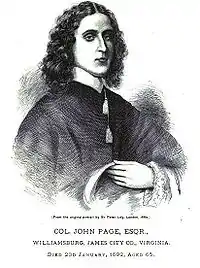
John Page was a member of the Virginia House of Burgesses starting in 1665. He played a pivotal role in supporting the efforts of Reverend Doctor James Blair in the founding of the College of William & Mary in 1693, which was located at Middle Plantation. Beginning in 1677, he is believed to have been an early advocate for moving the capitol to Middle Plantation, which eventually occurred in 1699, seven years after his death. (Middle Plantation was renamed Williamsburg in honor of King William III shortly thereafter).
The Royal African Company's agent in Virginia in the 1670s,[9] the Colonel was heavily involved in the Atlantic slave trade, not only trading and profiting on the chattel slave trade of human beings (agents received a seven-percent commission on sales),[10] but also enslaving numerous people on his various properties as well.[11][12]
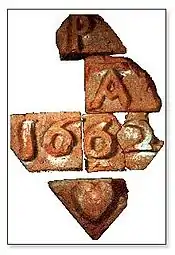
Colonel John Page and his wife Alice Lukin Page are buried at Bruton Parish Church in Williamsburg, Virginia.[5] Their tombstone, originally located within the church graveyard, was later moved to the church vestibule.[13] It reads: "Here lieth in hope of a joyfull resurrection the Body of Colonel JOHN PAGE of Bruton Parish, Esquire. One of their Majesties Council in the Dominion of Virginia. Who departed this life the 23 of January in the year of our Lord 1691/2 Aged 65"[14] The tombstone carries the arms of Page impaling those of Lukin.[15]
Family
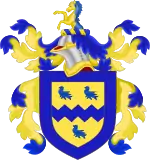
The Page family was one of the First Families of Virginia, which later included Mann Page III, his brother U.S. Congressman and Virginia Governor John Page, and later descendants such as U.S. Ambassador to Italy Thomas Nelson Page, and Virginian Railway builder William Nelson Page.
Colonel and Mrs. John Page named their eldest son Francis, and he also built a substantial brick home at Middle Plantation. (Present-day Francis Street in Williamsburg is said to be named for him). Another son, Matthew Page, was born in Virginia in 1659 and became a planter. He was one of the original board of trustees of the College of William and Mary, a member of the Governor's Council, and was active in public affairs. He died on January 9, 1703.
Their grandson, Mann Page I (1691–1730) (son of Matthew Page), also became a planter and wealthy landholder in Virginia, owning nearly 70,000 acres (280 km2) in Frederick County, Prince William County, and Spotsylvania County among other locations. In 1725, Mann Page I began the construction of Rosewell Plantation, the Page mansion on the banks of the York River in Gloucester County. Mann Page I's wife Judith Carter was the daughter of Robert Carter I. Mann Page I son John Page married Jane Byrd, a granddaughter of Colonel William Byrd I. One of John Page's great-grandsons was Confederate General Richard Lucian Page.
Mary Page, the daughter of Col. John Page, married Walter Chiles Jr., son of Col. Walter Chiles of the Virginia Governor's Council.[16] In his will of March 5, 1687, Col. John Page mentions his grandson John Chiles, as well as his "grandsonne John Tyler, sonne of my grand-daughter Elizabeth Tyler."[17] Elizabeth Chiles had married Henry Tyler of Middle Plantation, and thus became the ancestress[18] of President John Tyler.[19]
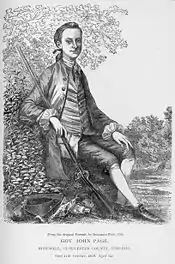
Because of the propensity of First Families of Virginia (FFV) to marry within their narrow social ranks for many generations, John Page is counted as a progenitor of many other FFV families. These include the families of Byrd, Chiles, Dilliard, Tyler, Pendleton, Burwell, Nelson, Randolph, Carter, Harrison, Waller and others.[5]
Legacy
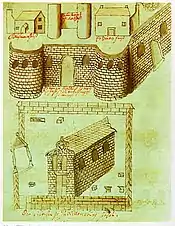
Several sites of the Page family in Virginia and West Virginia have historical and archaeological significance.
- The site of their property at Jamestown has been identified by the Jamestown Rediscovery project.
- Colonial Williamsburg has an extensive archeological study underway at the John Page home site at Middle Plantation (now Williamsburg).[20] Col. John Page owned much of what is today's Williamsburg, including Duke of Gloucester, Nicholson and part of Francis Street.[21]
- The ruins of Rosewell plantation, the home of early members of the Page family and one of the finest mansions built in the colonies, sit on the northern bank of the York River in Gloucester County. In one of its rooms, which are all of cubic dimensions, Thomas Jefferson, a friend and the college classmate of John Page (Col. John Page's great, great grandson) is said to have drafted the U.S. Declaration of Independence. In 1916, a fire swept the mansion leaving a magnificent shell which is testament to 18th century craftsmanship and dreams, and the site ongoing archeological studies.
- The Page-Vawter House, a large Victorian mansion, was built in 1889 in Ansted, West Virginia on a knoll in the middle of town.[22] Industrialist and mining manager William and Emma (née Gilham) Page raised their four children there, attended by a staff of 8 servants.[23] In the 21st century, it still stands as evidence of the once-thriving coal business and was listed on the National Register of Historic Places in 1985.
See also
References
- " Genealogy of the Page Family in Virginia, published in 1883" (PDF). Archived (PDF) from the original on February 18, 2017. Retrieved April 23, 2016.
- ""A Brief Guide to Bruton Parish Church"" (PDF). Archived from the original (PDF) on March 29, 2016. Retrieved June 14, 2010.
- Tyler, Lyon G., "Grammar and Mattey Practice and Model School", William and Mary Quarterly, July 1895
- In 1887 Henry Burke, the Somerset Herald of Arms in Ordinary, concluded that John Page was related to the Page family of Harrow on the Hill. Archived October 17, 2007, at the Wayback Machine
- Genealogy of the Page Family in Virginia, Richard Channing Moore Page, M.D., New York, 1893
- Dorman, John Frederick, Adventurers of Purse and Person, 4th ed., Vol. 2, pp494-495. Dorman states: "The longstanding identification of Alice Page ... as daughter of Edward Lukin has not been confirmed." After discussing the differences between the arms carved on the Page tomb, and the arms borne by known Lukin families, Dorman concludes: "There are other extant American gravestones engraved with arms differing from the actual arms of the individual, mistakes apparently having been made because the stone cutter referred to an armory or other collection of published arms when precise descriptions were not provided, or perhaps not even known, by the family of the deceased."
- Hobbs, Tom. "Summer Hill: History of the Summer Hill Site". VirginiaDigs. Archived from the original on March 25, 2012. Retrieved June 16, 2011.
- "A Brief History of Bruton Parish Church, brutonparish.org". Archived from the original on July 30, 2009. Retrieved June 14, 2010.
- "Plantation Life & Slavery". The Rosewell Foundation. Archived from the original on November 25, 2018. Retrieved November 25, 2018.
- "The Royal African Company - Supplying Slaves to Jamestown - Historic Jamestowne Part of Colonial National Historical Park (U.S. National Park Service)". www.nps.gov. Archived from the original on November 19, 2018. Retrieved November 25, 2018.
- "Slave Ancestor File". www.charlescity.org. Archived from the original on April 24, 2022. Retrieved November 25, 2018.
- McCartney, Martha W. (2003). "A Study of the Africans and African Americans on Jamestown Island and at Green Spring, 1619 – 1803" (PDF). National Park Service and Colonial Williamsburg Foundation, 2003. Archived (PDF) from the original on November 13, 2018. Retrieved November 28, 2018.
- "Photograph of the headstone of Col. John Page, vestibule, Bruton Parish Church, Williamsburg, Va., findagrave.com". Archived from the original on March 7, 2016. Retrieved June 12, 2010.
- Some Colonial Mansions and Those Who Lived in Them, Thomas Allen Glenn, Henry T. Coates & Co., Philadelphia, 1899]
- "Virginia Heraldica: Being a Registry of Virginia Gentry Entitled to Coat Armor, William Crozier, The Genealogical Association, New York, 1908". Archived from the original on November 17, 2020. Retrieved August 3, 2016.
- "A Timeline for Structures at Jamestown Relating to the Chiles Family, Historic Jamestowne, National Park Service". Archived from the original on September 1, 2009. Retrieved April 6, 2010.
- "Lieut. Col. Walter Chiles, Lyon G. Tyler, William and Mary Quarterly Historical Papers, Vol. I, pp. 75–78, USGenWebArchives". Archived from the original on February 19, 2012. Retrieved January 23, 2009.
- Elizabeth (Chiles) Tyler was the great-great-grandmother of President John Tyler.
- Encyclopedia of Virginia Biography, Vol. I, Lyon Gardiner Tyler, Lewis Historical Publishing Company, New York, 1915
- Photograph of John Page House Foundations, Middle Plantation in 1699, Colonial Williamsburg, Jennifer Jones, history.org Archived February 4, 2012, at the Wayback Machine
- Muraca, David F. "The John Page Site:Excavation of a Major House Site on the Bruton Heights Property". Williamsburg: Colonial Williamsburg. Archived from the original on November 5, 2010. Retrieved January 15, 2011.
- "Archived copy". Archived from the original on May 26, 2011. Retrieved October 11, 2008.
{{cite web}}: CS1 maint: archived copy as title (link) - "View - redOrbit". www.redorbit.com. Archived from the original on May 22, 2011.